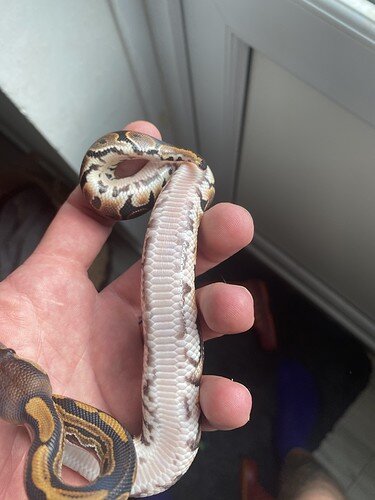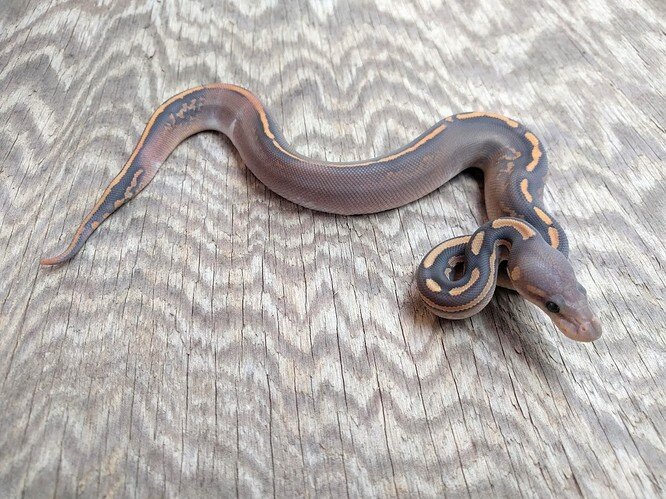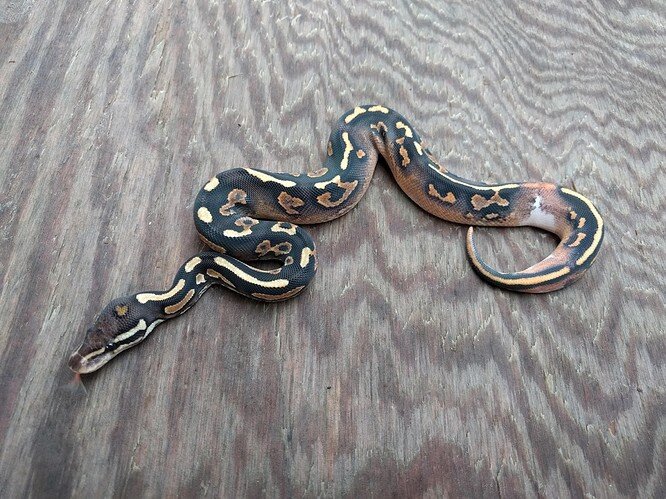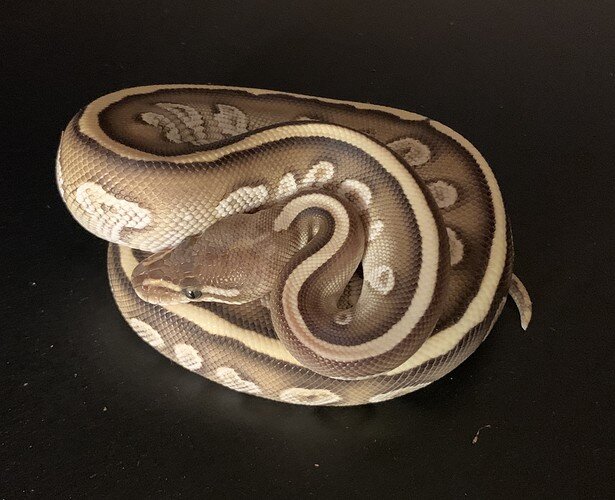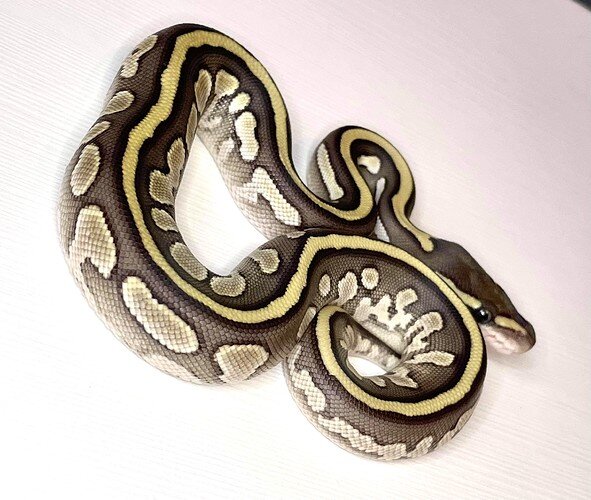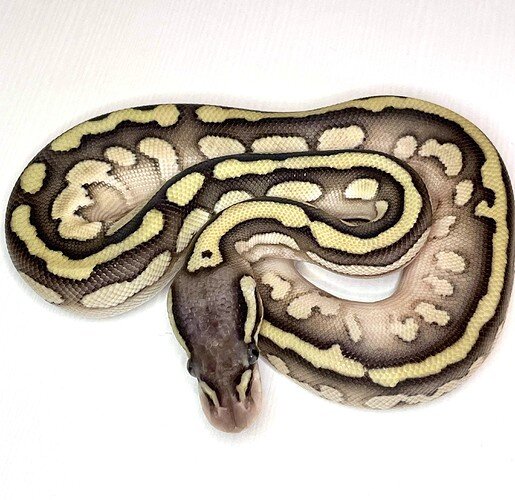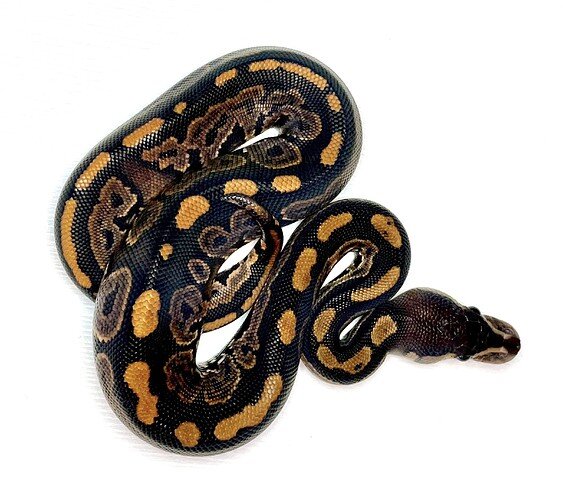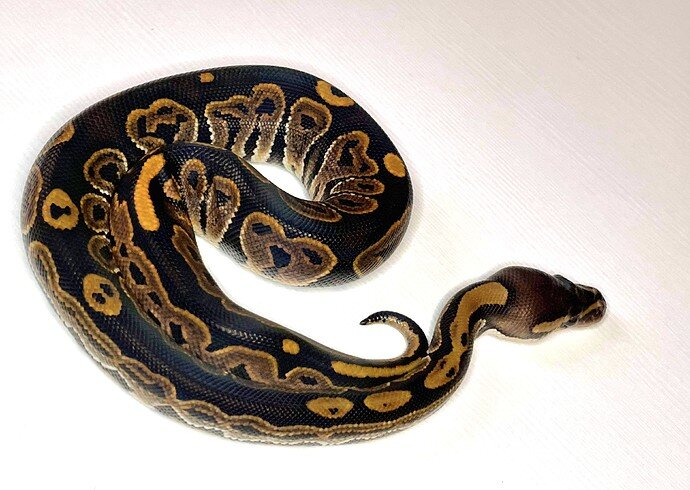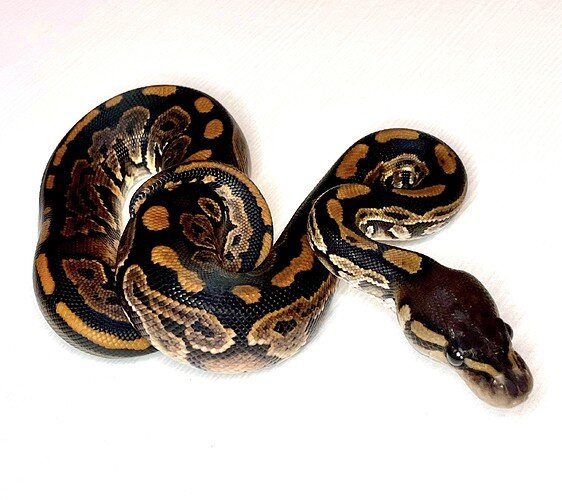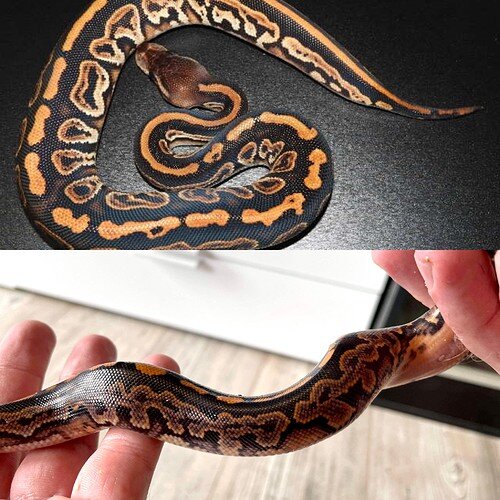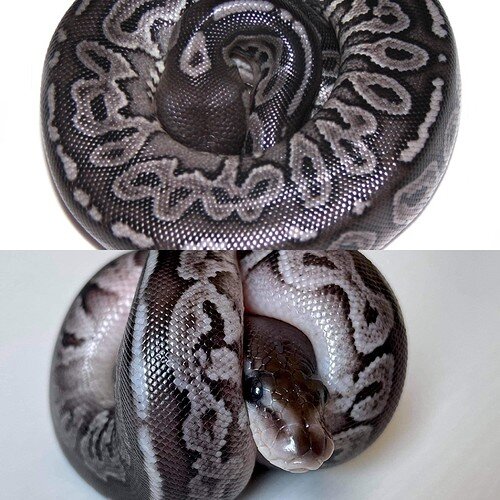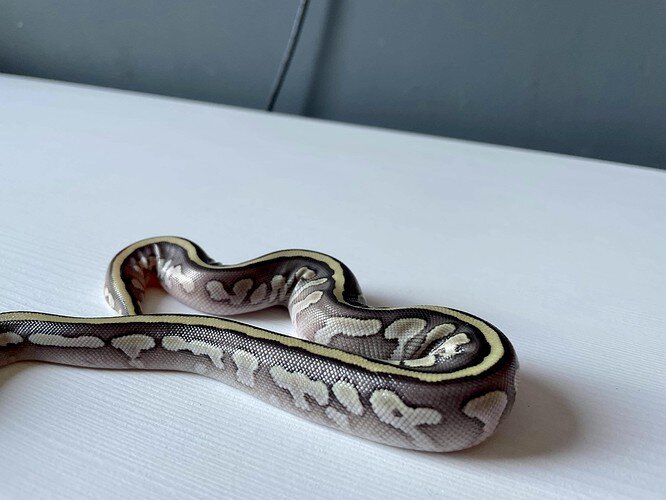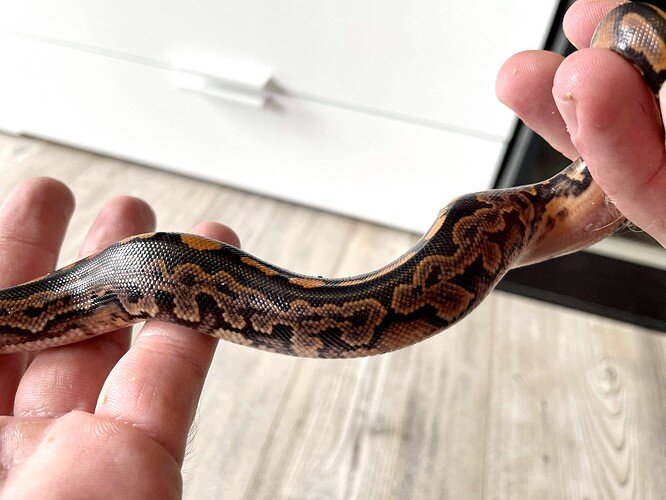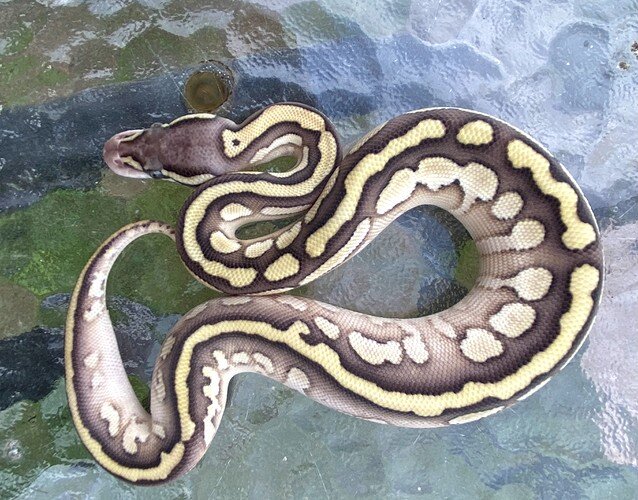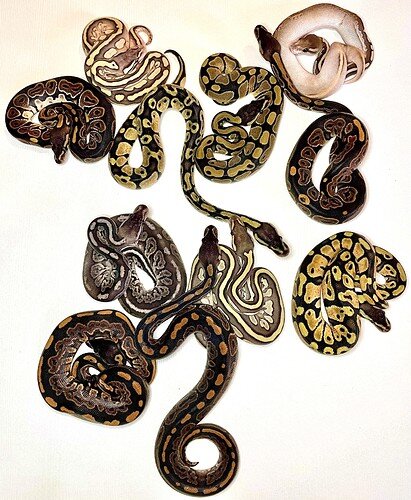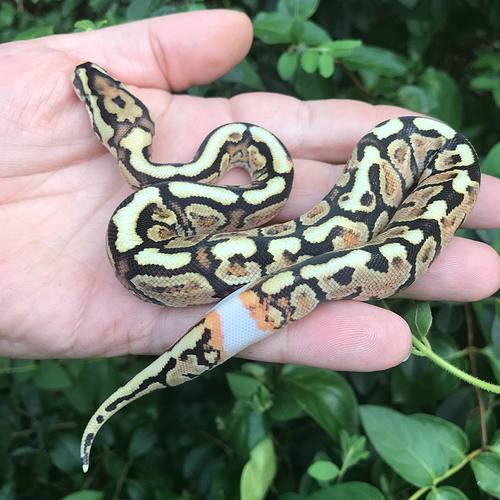Shot of the regular belly
I could be wrong but with the black pastelsI think the one is just a super nice example. Didn’t realize there was two lol.
What you’re experiencing here is the combined het influence of ghost and pied. I’ve produced a lot of het ghost pied animals and this is what they do.
In lesser, het pied regularly forces a dorsal stripe.
In cinnamon/black pastel and calico, het pied will regularly create a ringer.
In calico, het ghost will also create a ringer.
In yellowbelly, het pied will regularly cause a pure white belly.
Combine those genes with the het influence and you’ll get clutches like this. Het ghost interacts with het pied as a highlighter, double het ghost pied animals will nearly always be brighter than just their het pied or het ghost siblings.
There is no red stripe in those animals.
Here are some examples of 100% double het ghost pieds I’ve produced.
Fire yellowbelly cinnamon ghost het pied:
Fire yellowbelly cinnamon het ghost pied:
Enchi pied het ghost (notice the highlighter color):
Fire yellowbelly double het ghost pied (notice white belly):
Fire calico het ghost (no het pied, but notice the ringer):
I have many more examples, but these are some good ones. In general, ringers, white bellies, and dorsal stripes are what I look for in babies that are possible hets for pied. In babies that are possible het for ghost, I look for brighter than normal saturation and sometimes ringers. When both genes are at play, sometimes the double hets can be spectacular.
I’m not sure what het axanthic does normally (I don’t work with it) but when you stack recessives sometimes it does weird things to combos.
Your trying to say that is het influence??? Those two have an additional gene no doubt. You can see it in the sire also.
I think that the list of effects of pied and ghost is helpful (you know my thoughts, I’ll leave it at that LOL) but I don’t think it’s severe enough to cause these changes. I agree that there is another morph at play but I don’t have any ideas what it is.
The “single gene” black pastel is a black pastel yellowbelly (look at the checkerboarding along the sides of the belly), and I’d bet money it’s het pied. Occam’s Razor here applies… there are a LOT of hets in that pairing, those hets produce noticeable changes in phenotypes when combined, especially when dealing with multiple codominants. I really personally see no evidence after breeding ghost pied het combos for years that other genes are at play here other than those listed. I’d be gladly proven wrong if something does pop up in future experimental pairings, but I bet I’m right.
Leopard lesser possible pastel probable het pied for reference. Het pied stripes lesser out, especially when mixed with other genes, and can mimic cypress.
8 posts were merged into an existing topic: Could Piebald be inc-dom rather than recessive?
My Guesses (this is just at a quick glance):
- Black Pastel YB Pastel (looks to have a ringer)
- YB
- A very strange one for this Clutch. Almost looks like a Red Axanthic… but it has a orange ringer, which if I’m right should guarantee its not any sort of Axanthic… plus you have no reason to believe the dad is het. If you told me there was Fire in this pairing I would say Black Pastel Fire Pastel … maybe a low expression Lesser. Genetics is weird, combo phenotypes don’t always express the same as the individual traits. I’d definitely keep this and play around.
- Black Pastel het Pied … if this doesn’t prove out I’ll eat my shoes.
- Black Pastel Lesser Pastel
- Black Pastel Lesser YB
- Black Pastel Calico Lesser YB… maybe Pastel
- YB Pastel
- YB Pasetl Calico
- Lesser Black Pastel YB
- Black Pastel YB Pastel.
- Black Pastel Calico Lesser YB… maybe Pastel
Edit: Looking at this more, there is one thing I agree on…
Dude!.. what’s going on in this clutch?
Can finally reply now my 16 hour noob maxed out replies has worn off  I’ll just throw up some more pics. Maybe those of guys that were tagged can chime in
I’ll just throw up some more pics. Maybe those of guys that were tagged can chime in 
That orange and Black one is Awesome, but I have no idea what it is.
Have not seen one like it myself. Defiantly a keeper.
I’ll be sure to breed the black pastel that everyone thinks is het pied to one my pieds. I’ll Update in 2 years when upto weight 
 that would be awesome though.
that would be awesome though.
Was thinking how mad it would be if a few of them
Babies that hatched got all 3 of the hets and by some jackpot miracle you got the 3 gene combo  would be insane instant 6 year teleport lol.
would be insane instant 6 year teleport lol.
Pied, axanthic ghost with multiple genes  luck of the gods
luck of the gods
I still can’t get over how incredible that orange and black one is  good luck when it comes to proving it out! Keep us posted
good luck when it comes to proving it out! Keep us posted
that top one kinda looks like a high expression cinnamon pumpkin, but I’m not sure how that would work.
I am with @snowgyre on this, the dorsal striping you are seeing (especially in the Lessers) is combined influence of YB and het Pied. And that orange flushed BlkPastel is a BlkPastel Calico YB
I disagree the color is way off for me. No way het pied yellowbelly would blush it out that much and completely change the lesser coloration. Are you looking at the first set off pictures?
Gotta agree with snowgyre here. Over the years of breeding when you stack recessives you can get some very strange markings, colors and patterns that show out. Which is being seen in that one animal in particular.
How do you explain the ringers and pattern changes that will sometimes so up in hets?
This a spotnose fire yb double het paint clown.
They shown up in black pastel and champagne as well. They show up in normals. Ringers show up in literally any gene combo.
yes they can. You see them a lot in champange combos. Which is why i said SOMETIMES. Over the years of breeding i have seen over and over again that SOMETIMES hets will show a bit of an infulence on an animals pattern or overall color. You can see it in animals that are het ax they can be lighter in overall color especailly if they are pastel.
